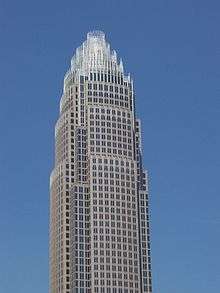Bank of Italy (United States)
The Bank of Italy was founded in San Francisco, California, United States, on October 17, 1904 [1] by Amadeo Giannini. It grew by a branch banking strategy to become the Bank of America, the world's largest commercial bank, with 493 branches in California and assets of $5 billion in 1945.[2]
The bank was established to serve working class citizens of the area, especially Italian Americans living in San Francisco's North Beach neighborhood. The bank survived the San Francisco earthquake and fire of 1906 and was one of the first to offer loans to businesses to help rebuild the city.
The Bank of Italy building—which later became a National Historic Landmark—was opened in 1908. Giannini had his office space in an open area on the first floor.[2] In 1909, the bank began opening branches in other cities. It had 24 branches by 1918,[3] at which time it was the first statewide branch banking system.
The Bank of Italy merged with the smaller Bank of America, Los Angeles in 1928.[2] In 1930, Giannini changed the name "Bank of Italy" to "Bank of America". As chairman of the new, larger Bank of America, Giannini expanded the bank throughout his tenure, which ended with his death in 1949.
Amadeo Giannini and the Bank of Italy were the basis for the classic 1932 Frank Capra movie American Madness, which was an original screenplay titled Faith by Robert Riskin.
Bank of America merged with NationsBank of Charlotte, North Carolina, in 1998. While NationsBank was the nominal survivor, the merged bank took the Bank of America name and operates under the original charter for Bank of Italy.
See also
- Old Bank of America Building (San Jose, California) - Bank of Italy
- Bank of Italy (Visalia, California)
- Bank of Italy - disambiguation to landmark buildings
- Banca d'America e d'Italia, sister bank
References
- ↑ "Bank of America". NNDB. Retrieved March 23, 2015.
- 1 2 3 Ralph J. Christian (June 1977), National Register of Historic Places Inventory-Nomination: Bank of Italy Building (PDF), National Park Service and Accompanying 3 photos, exterior and interior, undated. (384 KB)
- ↑ In 1918, another corporation, Bancitaly Corporation, was organized by A. P. Giannini, the largest stockholder of which was Stockholders Auxiliary Corporation. This company acquired the stocks of various banks located in New York City and certain foreign countries.
Further reading
- Josephson, Matthew, "The Money Lords; the great finance capitalists, 1925-1950", New York, Weybright and Talley, 1972.
External links
- National Historic Landmarks: Bank of Italy Building, San Francisco
- Bank of Italy Building (1917), Fresno
